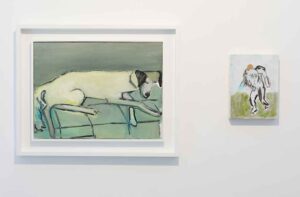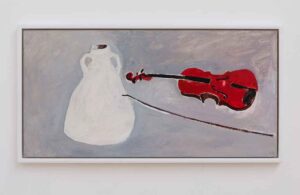“What Is This Place?” At the Newlyn Art Gallery – 22 April – 15th July An exhibition of paintings by eight artists
Whenever I walk into the Newlyn Gallery I am reminded of my first, and the gallery’s first, performance art piece, entitled Doubtless in 1994 put together by myself, Alaric Sumner, Rory McDermott, David Kemp, Rod Walker, Sandra Blow and Rose Hilton: the director of the gallery then being Emily Ash. I mention this event because it’s me, walking up the stairs, to be faced by younger artists, (except for one) working in painting: myself also being a painter, but of a vastly different age, almost in a different time warp altogether, but perhaps not so different an art scene compared to my own involvement in trying to come to terms with an art world wrapped up in its socio/economics and political adumbrations of the time, That is, from the end of the war to the “outbreak” from the galleries of artists from the stranglehold of the then cultural system. Why does this information matter? Simply because I ask myself, has anything changed? That is, fundamentally changed in the manner of how artists see themselves today?
I am now in the gallery with artists asking what is this place? After a while I begin to sense some confusion, perhaps feeling the trap engineered by the past decades of modernism and its iconography, its social and aesthetic ideals and the feeling that the only way to proceed is to run, and run like hell, painting quickly, stumbling, hoping certainty in the image while attempting to make a significant mark on board or canvas. But what is the place they are running to or away from? It’s not life or living, not feeling or sensibility, is it? Putting this mad race in a global context the arts seem to be expanding in many different ways of expression and the content itself diverging from one blind spot to another. While outside this fervent chase from kitsch to naivety and on occasion, sincerely made work, money laden art institutions and international art shows continue on their way enticing some ‘unlucky’ artists into their fold. Here in Newlyn we have but eight painters proclaiming their right to engage with a public, and, hopefully revealing a glimmer of light or maybe to be beguiled by forces outside their ‘control’.
In the brief paper catalogue of ‘what is this place?’ some words catch my eye: Memory and Truth, Commonplace and Cosmic and the idea of Questioning in Paint.
I would like to add, Life and Reality, and, in a sense all art is contained by the last word, reality. What is the reality of life? How do we see reality, how do we feel reality, can we get near to reality, how do we express reality? If painting can touch reality and make the audience aware of a new reality, surely something is achieved but how sure are we?
What is the place? For me, is answered by observing the closeness of the arts to philosophy: they are one and the same when viewed as a way of seeing and thinking.
Aesthetics has always been associated with the arts through investigations in perception, and perception is the way we humans see the world and our place in the world. Artists are in the business of seeing. However, a sense of quality and value are attached to seeing and what we see as objects in the world is how the world is, even as it changes from one light to another, from one perspective point to another, it is the same world but we can see it differently. Importantly, we have made the world; without us it doesn’t exist. Painting however is a record of our existence and how we have seen the world. Obviously this is a truism as history demonstrates, that is if we believe history, but the present in which we live concerns us, and the eight painters in particular.
So, what do I look for in these eight painters? Before going into the work itself, I would like my readers to understand the premise I will be working to in my discussion. It is as you might have guessed; what is this place of reality (?) and it’s precisely because all quality and values are in this simple and at the same time complex word and they are so constituted as being the reality of our existence as being human.
I have great reservations on the description of art as being expressive, personal expressive or expressiveness in general through the manipulation of the painted surface, they are two different things, but as Herbert Read has said, ”The purpose of art is not to express a mood or state of mind, if so it’s an illusion and not a reality” The fallacy of emotions is upheld by Igor Stravinsky “ When we recognize our emotions, they are already cold, like lava” Humanity is more than our emotions or memory. It is only when we try to go beyond the idea of painting itself can there be found art as an object, as a thing in itself, but portrayed through its visual image. However, this ‘view’ of art is not definable. As an observer the object of art retreats as soon as we try to fathom its depths. It retreats from what we recognize as painting to some other place that is unobtainable, always out of reach. Though deep down we may be able to feel a touch of its essence. However, where a painting is pattern, surface manipulation, as some of the ‘eight painters’ reveal we are conscious of use of materials only. A comparison is easily made between frozen movement of paint and the sense of something free from form, colour, tone, texture and composition, away from material into essence. Derrida has a wonderful description: “Four times round the frame” he is speaking here of the frame of discourse and its movements, that is, from the outside to the inside of the frame through to four kinds of understanding, experiencing the experience through poetry, philosophy and art. Art is as discursive as philosophy and is  also concerned with the speculation of knowledge.
also concerned with the speculation of knowledge.
In the light of ‘eight painters’ let’s turn to the question of the avant-garde. In this quest I would say it’s pointless. Duchamp ‘hung up is boots’ on the ready-made as a way of saying, that’s an end, finis. Since then what a tumbling and scrambling scene we have in art. I see that the avant-garde is catching itself by the tail. Lets face it there will be no avant-garde as such, only something different. The ‘eight painters’ in Newlyn Gallery most probably testify to this fact. But, alas, we will go on looking for it, wont we?
Would this mean to look again at the aspirations of modernism and its desire to be universally understood, perhaps seeing with fresh eyes what the socio/economic situation in the arts and the inhumanity in humanity are throughout the world? And perhaps a look at the vast gap we have between nature and technology, between art and science. Why not agree with Bruno Latour “We have never been Modern”. Because there has, and still, is a distinction between nature and society, between human and things, between us as human beings, and the nature of the world, there is just the chance that art could approach this dilemma. Don’t we all feel the pressure of material life, its emphasis of material progress and that we are tending toward being part robot by not thinking through the real issues in education and the teaching of humanities of which art is an essential part? This exhibition of ‘eight painters’ at the Newlyn Gallery should be posing this vital question, who is?
Ken Turner
(The images came to us without titles. They are reproduced so as to reinforce the writer’s sense of the exhibition.)
Mary and Ken Turner ran Action Space in central London. Available through Amazon: ‘Crashing Culture’ by Ken Turner and ‘Action Space Mobile’ by Mary Turner. Huw Wahl films on Herbert Read and Action Space are available. His last film entitled ‘Everything Lives’, on the life of an artist.
www.hctwahl.com
www.imaginativeeye.co.uk
Volume 32 no. 1 September/October 2017 pp 31-32
